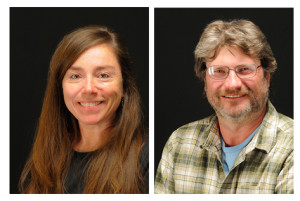
Dr. Jennifer Lindline and Dr. Michael Petronis
Las Vegas, N.M. – A new state-of-the-art microscope at Highlands University will open up new research and employment opportunities for geology students.
A National Science Foundation grant funded the $43,642 high-magnification microscope that makes it possible to identify and analyze very thin sections of minerals at the 30-micron level.
“There’s a small but economically important subset of minerals that contain elements like iron, copper and lead that can only be identified in reflected light like the kind this new microscope provides,” said geology professor Michael Petronis, the principal investigator, or lead researcher, for the NSF grant. “This opens the door for new research and job opportunities for our students in the field of economic geology – mineral and hard rock exploration and extraction,” Petronis said.
The new microscope more than doubles the magnification that is available for geology research at Highlands. It also has a digital camera attachment for gathering and storing images.
“This new research-grade microscope gives an automated assessment of minerals present in a sample, making research more productive, efficient and precise. We will now also have the capability to obtain high-resolution publication quality images of thin sections of rocks and minerals, enhancing how we showcase student and faculty research,” Petronis said.
Before this new microscopic automation, the inventory of minerals present in a thin sample were manually counted using a laborious microscopic grid with 1,000 points.
Petronis said the new microscope is an important new tool for the research he and his students conduct in his Paleomagnetic-Rock Magnetic Laboratory at Highlands.
“The microscope’s reflective light capabilities will allow us to identify the magnetic materials that are important for understanding how the Earth’s magnetic field is recorded in geologic materials, with applications ranging from gaining a better understanding of how volcanoes grow to how the Earth’s tectonic plates move,” Petronis said.
Fellow geology professor and Natural Resources Department chair Jennifer Lindline is the co-principal investigator for the NSF grant.
“Geologists examine the earth at all scales, from the mega level of continental plates to the macro level of rock outcroppings and the microscopic level of mineral properties,” Lindline said. “This new microscope gives our Highlands students the opportunity to pursue geology research at the microscopic level for the first time in our laboratories on campus.”
Lindline said this kind of geology microscopy expertise is rare.
“This type of of hands-on highly specialized research is the kind of high-impact practice that promotes the continued success of our environmental geology students academically and in the job market,” Lindline said.
She added that the new microscope will transform the way she teaches optical mineralogy in the classroom.
“This microscope’s camera interfaces with a computer software program that gives me the opportunity to project high-quality images of minerals and rock sections on a screen to discuss features with all my students at once,” Lindline said.
She said the new microscope will also be used for cross disciplinary faculty and student research at Highlands.
“For instance, archaeologists can examine pottery shards for source analysis, water scientists can study microscopic invertebrates, or bugs, at higher magnification for water quality studies, and biologists can study animal and plant cell structures with more precision,” Lindline said.
